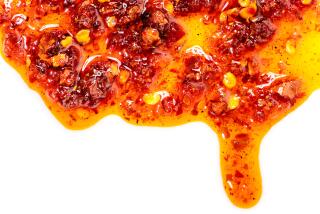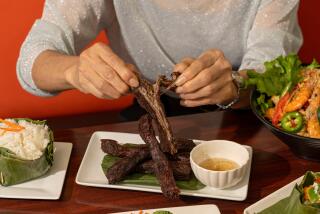A Mystery Begins in the Backyard
Firing up my barbecue a few months back, I started wondering about sauces. Not the respectable French sauces that food writers deal with all the time--and that nobody ever makes in the backyard, it occurred to me as I sucked thoughtfully on a beer--but the bottles of steak and barbecue sauce I had lined up at the ready. Where’d they come from? What’s their story?
French chefs, who base their cooking on cream or reduced meat juice, have no use for these “violent Anglo-Saxon sauces.” The rap against them is that they make everything taste the same. But come on, I thought, nobody complains that truffles make everything taste the same. If you want a particular flavor, that’s what you want. Sometimes it’s sauce espagnole, sometimes it’s got to be Worcestershire.
In any case, who uses the same sauce on everything? Who puts ketchup on ribs and T-bone? That’s what barbecue sauce and steak sauce are for. And the number of barbecue sauces is beyond counting. In fact, concocting barbecue sauces is one of our most vigorous culinary activities, right up there with chili-making.
It turns out that bottled sauces have a long, and colorful history stretching back more than 300 years. The story begins in 17th century England, when English home cooks were using either melted butter or plain gravy for all their sauce needs. Over in France, Louis XIV’s chefs had just created an impressive new haute cuisine emphasizing huge quantities of meat. Many French sauces were now based on an expensive ham concentrate called coulis.
On returning from exile in 1660, Charles II introduced the latest French dishes to the English court, but English home cooks refused to go along with what they called “French extravagance.” This might sound like simple, unimaginative penny-pinching, and probably it was, at least to start with. But as England grew more prosperous and able to afford the elaborate French style, English home cooks stubbornly kept putting gravy or butter on everything, varying them by adding wine, mushrooms, anchovies, pickles and the like.
Meanwhile, the East India Co. was making England a major player in the Far East. English voyagers found the people of China and Southeast Asia using their own liquid seasonings, fish sauce and soy sauce. Like two favorite English sauce additives, mushrooms and anchovies, both Asian sauces were based on a protein-rich ingredient, giving them umami, the “tastiness” quality that the Japanese find in mushrooms, soy products and dried fish.
The English were enthusiastic right from the start. “Suoy is the choicest of all Sawces,” gushed John Ovington in “A Voyage to Suratt in 1689.”
There was already a craze for Indian ingredients in Ovington’s day. Indian mango pickles were so fashionable (and expensive) that English cooks were making thrifty imitations out of peaches, melons or cucumbers. In 1699, one writer gave a recipe for a “mango” that was merely pickled green walnuts: “a more agreeable Mango,” John Evelyn wrote, “than what is brought us from abroad; which you may use [as a flavoring] in any Sauce, and is of it self a rich Condiment.”
Once the English started importing ketchup and soy sauce, they naturally started imitating them too. But they were a little vague about what these sauces were, and none of their 18th century “ketchups” or “soys” tastes much like the real thing to us.
In fact, it’s hard to say what they thought the difference was between soy and ketchup. In their defense, there was also confusion in the Far East. In Malaysia, where the English first encountered it, kecap originally meant a Southeast Asian fish sauce like the Thai nam pla or the Vietnamese nuoc mam, but today kecap means soy sauce there.
You might expect English cooks to make their ketchup from anchovies, which have the same salted-fish flavor as nam pla. They did make some anchovy ketchup, but from the start their favorite ketchup was extracted from salted mushrooms. Probably they were really trying to duplicate soy sauce--by mixing chopped mushrooms with salt and leaving them overnight, they made sure the juices would oxidize and turn brown. The second most popular kind, pickled walnut “ketchup” (pretty close to what John Evelyn had been calling a mango in 1699), had an even darker and more soy-like color.
The basic ketchup idea was the brine from pickling something, flavored with various spices, usually including cloves and mace. These imitation ketchups were handy not only for the home cook, but for the traveler who faced boring food in small-town inns, to say nothing of tedious ship’s rations on long ocean trips. They spread quickly throughout the English-speaking world and even beyond. By the 19th century, Russian housewives were making their own “mushroom soy” (soya iz shampinyonov).
Doctoring the Sauce
Once you had a couple of ketchups on hand, you could make all sorts of compound sauces by doctoring them with wine, vinegar, herbs and spices. (If you left the ketchups out and just mixed wine with herbs and spices, you had what was called traveling sauce, because it kept so well on journeys.) The result was an explosion of bottled sauces, much like today’s profusion of barbecue sauces. “By the mid-nineteenth century,” wrote the English food writer Elizabeth David, “hundreds of British families must have had their own--or what they thought was their own--formula for some such sauce.”
Sauces of this sort were made commercially starting in the 1760s. One of the first big sellers was Harvey’s Sauce, a mixture of wine, anchovies and both mushroom and walnut ketchups. It had been created by a London innkeeper named Peter Harvey, whose sister, Elizabeth Lazenby, sold her own sauce, Lazenby’s Anchovy Essence. Eventually there were hundreds of sauces on the market, the most durable being Worcestershire (1838), which mixes anchovies with tamarind, vinegar and some real, Chinese-type soy sauce.
“The usual way of eating these sauces,” explained Eliza Leslie in her “Directions for Cookery” (1837), “is to pour a little on your plate, and mix it with the melted butter. They give flavour to fish that would otherwise be insipid, and are in general use at genteel tables.... They are in great variety, and may be purchased of the grocers that sell oil, pickles, anchovies, &c.;”
They were brought to the table in cruets or special little bottles called casters. The cult of bottled sauces is behind a lot of puzzling Victorian antiques: the silver-plated stands that held sauce cruets, the picnic baskets fitted with bottle-sized compartments, the silver labels engraved with the words “Harvey’s” or “Quin’s” or “Tapp’s,” which were hung around the necks of cut-glass sauce flagons.
The next fateful step in sauce evolution was the invention of tomato ketchup, some time before 1800. It answered a pressing question: What do you do with your tomato crop? Even today’s half-ripe supermarket tomatoes are notoriously perishable, and something really had to be done when the kitchen garden was overflowing with ripe tomatoes. The solution was to boil down tomato juice with salt and spices, and bottle the concentrated result with vinegar as a preservative. Not surprisingly, it quickly became the favorite ketchup in this country, though mushroom ketchup remained common until around 1900.
This original tomato ketchup was not sweetened, and it wasn’t meant to be used by itself. You added it to butter or gravy in the usual way, creating a spicy instant tomato sauce. As Andrew F. Smith tells in “Pure Ketchup: A History of America’s National Condiment,” it wasn’t until 1876 that sugar became a regular ingredient in tomato ketchup. Eventually, as we know, Americans started using ketchup by itself with no idea of doctoring gravy or melted butter.
The idea of tomato ketchup soon reached England, and there is an English recipe dating from 1816. It includes anchovies for a more traditional ketchup flavor. When some Americans tried to market tomato ketchup in England in 1837, they were told they’d have to call it tomato chutney, possibly because English customers would expect to taste anchovies in it.
At any rate, anchovy-less tomato ketchup established itself in England during the 1840s. And then came an unexpected consequence. To compete with tomato ketchup, English sauce manufacturers devised what we now call steak sauces and what the English call brown sauces. They contain the sort of flavorings that went into the older ketchups--vinegar, garlic, onions, sweet spices, cayenne, sometimes even anchovies--plus tomatoes and typically a fruit such as raisins or dates.
Could This Be the Source?
So there’s the twisted family tree of steak sauce, winding its way back to the 18th-century English attempt to duplicate Asian sauces. But there may be another line of descent as well.
Harvey’s Sauce was essential for a popular 18th and 19th century dish called deviled bones, which was made by coating leftover beef or chicken bones with devil sauce and roasting them brown, making something enjoyable to gnaw. There were several kinds of devil sauce, including brown devil (a paste of butter, flour, mustard, chutney and Harvey’s) and white devil (cream, mustard, mushroom ketchup and Harvey’s). Eventually, Worcestershire sauce replaced Harvey’s in devil sauces.
Now, what if tomato ketchup invaded the devil sauce recipe, the way it invaded traditional English ketchups to give birth to steak sauce? That could be the source, or one of the sources, of American barbecue sauce.
Think about it. Like devil sauce, a lot of old-time barbecue sauces contain mustard. Even today, a lot of barbecue sauces have Worcestershire in them. The later development of barbecue sauce would reflect our raging national sweet tooth and taste for hot peppers.
So welcome to the reunion, soy sauce, fish sauce, Worcestershire sauce, tomato ketchup, A-1 sauce--and probably you, too, Memphis-style barbecue sauce. You’re all part of the same family, apparently. One thing’s clear, at any rate: None of you is French.
More to Read
Eat your way across L.A.
Get our weekly Tasting Notes newsletter for reviews, news and more.
You may occasionally receive promotional content from the Los Angeles Times.







